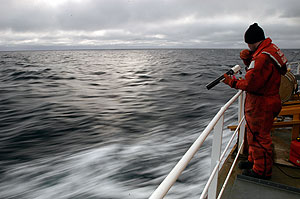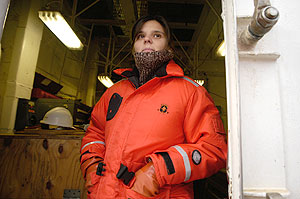|
|
 |
Daily Update
Calendar
Dispatch 23 - September 23, 2004
By C. A. Linder
Weather conditions: Mostly cloudy skies, snow flurries, 15
kt winds, 3-5 ft seas, air temperature 33°F
The Hunt Continues
A biting wind greeted me as I stepped out onto the weather deck this
morning. The temperature has been hovering right around freezing for
the past few days, and the decks and railings were slippery with ice.
Snow flurries came and went throughout
the day as we continued our hunt for eddies along the shelf edge using
XBTs.
This question about diving in the Arctic comes from the Morse
Pond School in Falmouth, Massachusetts.
Question: How long can you stay under water without
freezing?
I asked the Healy dive officer, Lieutenant Junior
Grade Jessica Noel, to answer this question.
Jessica: "The amount of time you can spend in the
water without freezing depends on the temperature of the water and
what kind of suit you are wearing. In a regular swimsuit or shorts,
the water has to be above 70°F
for you to be able to stay in it for a long time. Below 70°F,
your body will lose heat and you will start to shiver. The colder
the water is, the sooner you start to shiver. The loss of body heat
is called "hypothermia." For divers, this is important because once
we start getting cold, it becomes hard for us to work with tools and
concentrate on what we are doing. We wear very thick wetsuits or dry
suits up here in the Arctic Ocean so that we can stay in the very
cold water long enough to complete our work. Up here, the water is
often near freezing (about 35°F).
When the water is below 40°F,
we wear dry suits (waterproof suits that keep us dry by keeping the
water out) with sweatshirts and pants underneath to keep us warm.
This way we can stay in the water for about 45 minutes to an hour
before we even start to feel a little chilly, and it would take many,
many hours for us to actually freeze. If someone fell in this water
(at 35°F) without
a drysuit or other thermal (heat) protection, they would only live
for about 6-10 minutes before freezing."
 |
|
 |
| Marine Science Technician Daniel Gaona communicates with the science lab on walkie-talkie after launching an XBT. |
Celia Martin Puertas waits to watch an XBT drop. |
| Click to enlarge | |
Click to enlarge
|
This question is from Karen in Amarillo, Texas.
Question: I was wondering how many support staff does this expedition require and what are those functions? More specifically, who does the cooking and laundry?
Answer: Hi Karen, thanks for writing. For this answer
I visited to the Food Service Specialists, headed by Senior Chief
Sean Forsythe. He took me on a tour of the huge
storage rooms and freezers where the food is kept. He told me
that when the Healy gets underway for the summer season,
he is responsible for buying six months of food, plus an extra 30
days worth, "just in case we get stuck in the ice." So how much does
all of this food cost? Over $300,000.. Plus, when the ship pulls into
port in between science missions, like when we were picked up in Dutch
Harbor, Sean buys another $20,000-$30,000 worth of fresh produce.
It's amazing to me that on day 23 salads and fruit are still available.
There are five food service specialists on the ship and they do all
of the cooking, four meals a day for the entire time the Healy
is at sea. They regularly put in 14 hour days (starting at 5:30AM)
and never get a day off on the weekends or holidays. Undoubtedly they
have one of the toughest jobs on the ship. Regarding laundry, there is a
large laundry room in the bowels of the ship with industrial-size
washers and dryers. Everyone is responsible for doing their own laundry.
 |
Science
Crew Facts

Sarah Zimmermann and
her partner Bill are building a kayak. When it is built they
will use it to paddle around the Gulf Islands near their home
in British Columbia, Canada. |
Unfortunately, our sampling today did not reveal
any other eddies. Overnight tonight we will find out if the first
eddy we encountered is still intact. This
plot shows a two-dimensional view of the temperature of the ocean
along our first transect, or line of XBT stations. The X-axis is the
distance along the line and the Y-axis is the depth. The eddy is clearly
visible as the blob of purple (colder) water at 150 meters depth.
But, eddies don't last forever--eventually they get mixed away into
the basin water. We are hoping that this one is still there, so we
can map it out in detail using our instruments over the next few days.

|
Traducido al Español por
Celia
|
La caza continua
Una ráfaga de viento me dio la bienvenida esta mañana al salir a cubierta. La temperatura ha sido buena comparada con la que hizo unos pocos dias por debajo de los 0ºC, y las cubiertas y los riles estaban resbaladizos por el hielo. Los remolinos de nieve van y vienen y nosotros seguimos a la caza de deis usando los XBTs.
A la pregunta acerca de bucear en el Ártico procedente de la
escuela Morse Pond en Falmouth, Massachusetts.
Pregunta: ¿Cuánto tiempo puedes estar bajo el agua
sin congelarte?
Le pregunté al oficial de buceo del Healy, Lugarteniente
Jessica Noel, y su respuesta fue esta.
Jessica: “La cantidad de tiempo que tu puedes estar
en el agua sin congelarte depende de la temperatura del agua y de
la clase de traje que lleves. Con un traje de neopreno normal o corto
y a una temperatura del agua por encima de 70ºF tu puedes estar mucho
tiempo buceando. Por debajo de 70ºF, tu cuerpo empieza a perder calor
y empezaras a tiritar. La pérdida de calor del cuerpo se llama hipotermia.
Para los buceadores, es importante porque una vez que empecemos a
tener frío es difícil trabajar con herramientas y concentrarse en
lo que se está haciendo. Usamos trajes muy gruesos o trajes secos
para bucear en el océano Ártico para poder estar el tiempo suficiente
para completar el trabajo en esta agua tan frias. Aquí el agua, a
menudo, está cerca del punto de congelación (35ºF). Cuando el agua
está por debajo de 40ºF debe utilizarse el traje seco (repelente del
agua que mantiene al cuerpo seco) vestido con tu ropa normal. Este
traje nos permite estar desde 45 minutos a una hora antes de sentir
algo de frío. Si alguien cayera en esta agua sin un traje seco o otra
protección termal, solo durarian 6-10 minutos antes de congelarse.
Esta pregunta es de Karen de Amarillo, Tejas.
Pregunta: Me preguntaba ¿cuanto personal es necesario
para realizar las funciones del baco? Mas específicamente, ¿Quién
cocina y lava la ropa?
Respuesta: Hola Karen, gracias por escribir. Para
tu pregunta he visitado al servicio de hosteleria, dirigido por el
jefe Sean Forsythe. Él me llevo a la sala de abastecimiento y al congelador
dónde se guarda la comida. Me contó que cuando llega el verano, es
el responsable de comprar la comida para los seis meses siguientes,
mas 30 dias extra, en caso de quedarse atascado en el hielo. ¿Cuánto
cuesta esto? Alrededor de 300,000 dólares. Además cuando el barco
para en puerto porque tiene alguna campaña científica , como cuando
nosotros embarcamos en Dutch Harbor, gasta alrededor de 20,000 o 30,000
dólares en productos frescos. Es increíble para mi, que el dia 23
de campaña aun haya ensalada y fruta fresca. Hay 5 cocineros en el
barco y ellos cocinan cuatro comidas al dia durante todo el tiempo
en la mar. Normalmente trabajan 14 horas al dia (comienzan a las 5.30
de la mañana) y nunca tienen un dia de descanso, ni en fines de semana
ni en vacaciones. Indudablemente ellos tienen el trabajo mas duro
del barco. Respecto a la lavandería, el barco dispone de lavadoras
y secadoras donde tu puedes hacer la colada cuando lo necesites.
Desafortunadamente, nuestro muestreo de hoy no ha detectado otros eddies. Esta noche sabremos si el hedí que hemos encontrado esta aún intacto. Con el programa informático que utilizamos veremos en dos dimensiones la temperatura del océano de nuestro primer transecto, o la línea de XBT. En el eje de las X la distancia de los puntos de muestreo en la línea, y en la Y la profundidad. Los eddies son visibles en un color púrpura (agua mas caliente) a una profundidad de 150 metros. Pero los eddies no son permanentes, se disipan mezclándose con el agua que les rodea. Esperamos que este aun este entero para poder muestrearlo en los próximos dias.
 Previous
Dispatch
Next Dispatch Previous
Dispatch
Next Dispatch

Back to Calendar
|
|




